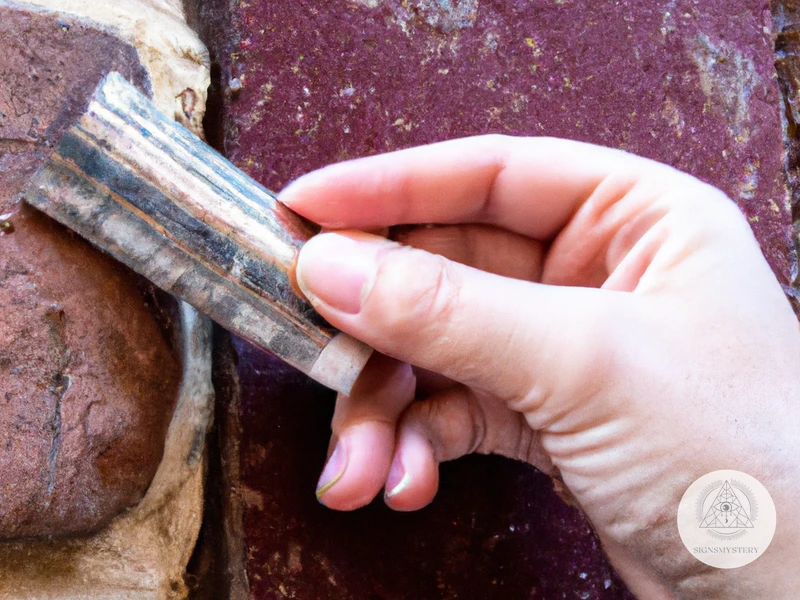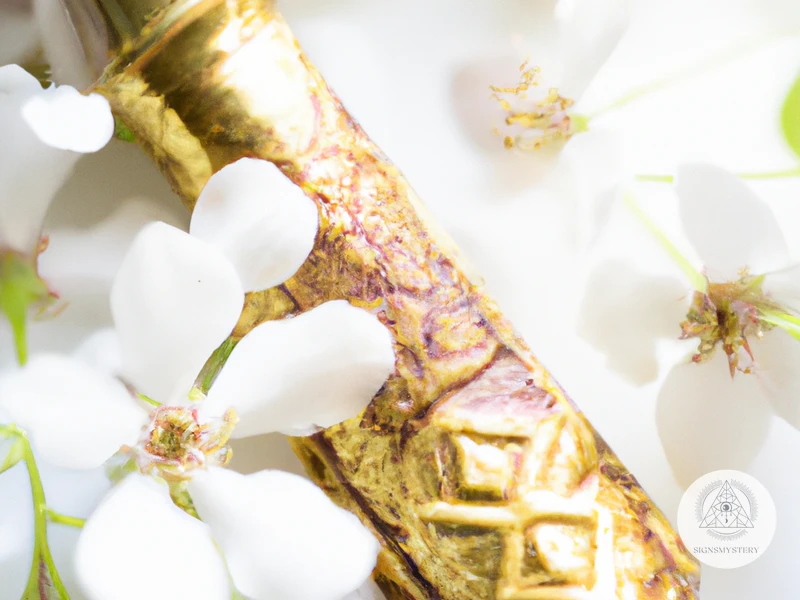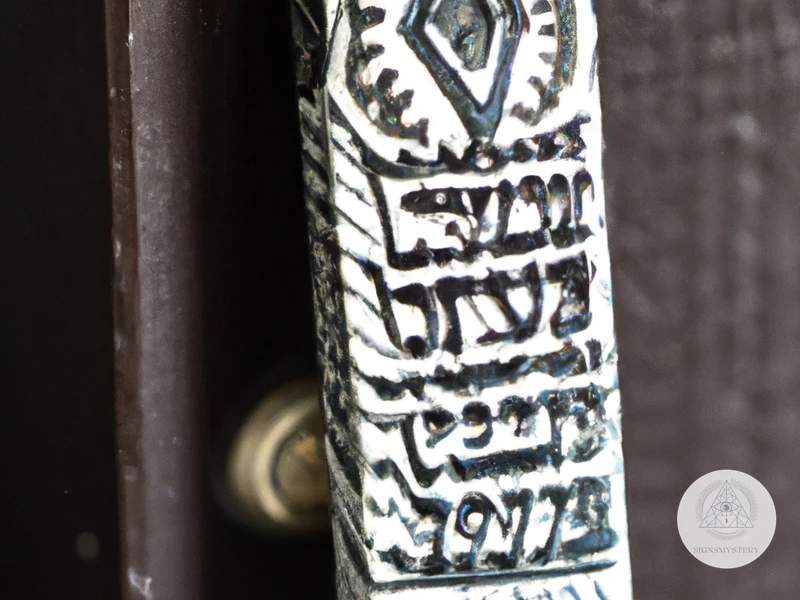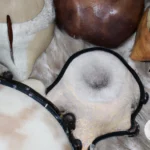The mezuzah is an important symbol of the Jewish faith that has been in use for thousands of years. It is a small, rectangular case that contains a parchment with verses from the Torah. The mezuzah is affixed to the doorpost of Jewish homes to signify God’s protection and presence within the household. While the concept of the mezuzah is well-known in Jewish culture, many people outside of the religion may not fully understand its history or significance. In this article, we will explore the mezuzah’s origins, materials, ceremony, and maintenance, as well as its symbolism and importance in Jewish faith.
What is a Mezuzah?
A mezuzah refers to a piece of parchment inscribed with religious texts that are enclosed in a protective case. This parchment, called a klaf, contains the words of the “Shema Yisrael” prayer, which expresses the Jewish people’s declaration of faith. The mezuzah is mounted on doorways of Jewish homes as an expression of Jewish identity and faith.
The word “mezuzah” means “doorpost” in Hebrew, and it has been used for millennia as a symbol of Jewish faith and a form of doorway protection. The mezuzah is not just a decorative item, nor is it made to ward off evil spirits. Instead, it serves as a reminder to Jewish people of their covenant with God and their duty to fulfill his commandments.
In Jewish tradition, the mezuzah represents the idea of God’s protection, with the parchment inside serving as a physical embodiment of divine grace. Placing a mezuzah on the doorway is believed to bring blessings to the home, and it is a requirement for observant Jews to have at least one mezuzah in their home.
It is customary to kiss the mezuzah upon entering or exiting a room with a mezuzah. This act is meant to show respect for the sacred text contained within and to remind us of the significance of Jewish faith in our everyday lives.
A mezuzah is a doorpost that contains a parchment with the “Shema Yisrael” prayer inscribed on it. It is a symbol of Jewish identity and faith and serves as a reminder of the Jewish covenant with God.
History and Significance
The Mezuzah is an important symbol of Jewish identity and faith that has been used for centuries. The word mezuzah in Hebrew means “doorpost” and refers to a small parchment scroll that is placed inside a decorative case which is then affixed to the doorpost of a Jewish home.
The origin of the Mezuzah dates back to biblical times when the Hebrews were commanded in the book of Deuteronomy to “write the words of this law on the doorposts of your house and on your gates.” This commandment is known as the Shema, which declares the oneness of God and is recited twice daily by Jews.
Over the centuries, the Mezuzah has developed a rich tradition and is regarded as a powerful symbol of protection for the home and its inhabitants. According to Jewish belief, the Mezuzah serves as a reminder of God’s presence and protection, and as a symbol of the covenant between God and the Jewish people.
The Mezuzah is also believed to have spiritual significance, as it serves as a doorway between the secular and the sacred. It is said to provide a spiritual barrier that separates holy space from profane space, and to create a sense of sanctity and connection with God.
The Mezuzah case, which holds the parchment scroll, comes in a variety of materials and designs. The case can be made of wood, metal, glass, or enamel, and is often adorned with intricate designs and symbols. The Mezuzah case can also be personalized to reflect the individual tastes and personalities of its owners.
The Mezuzah has a rich history and significance in Jewish faith and culture. It serves as a powerful symbol of God’s protection and presence, as well as a reminder of the covenant between God and the Jewish people. The Mezuzah also has spiritual significance, creating a sense of sanctity and connection with God. The Mezuzah is just one of many important Jewish symbols, including the Star of David, the menorah, the Hamsa, the Torah scroll, Hebrew letters, and the Kippah.
Materials and Design
The mezuzah can be found in a variety of sizes and materials, ranging from simple to ornate designs. The choice of design and materials used is a personal preference, however, there are some traditional materials that are commonly used.
The most traditional type of mezuzah is made from parchment or klaf, which is a specially prepared animal skin. The parchment is inscribed with the Hebrew letters “Shin” “Dalet” and “Yud,” forming the name of God. The parchment is then rolled up and inserted into a protective casing.
Mezuzah casings can be made from a variety of materials such as wood, metal, stone, ceramic, and even plastic. The casing can be simple or intricately designed, engraved with various Jewish symbols such as the Star of David, the Menorah, or the Hamsa. The engraving of Jewish symbols on the casing emphasizes the connection between the mezuzah and Jewish faith.
Some people choose mezuzahs that have intricate and ornate designs made out of precious metals, such as gold or silver. These mezuzahs can be quite expensive because of the value of the material used but they also make a beautiful addition to any doorpost.
It is important to note that the design of the mezuzah is not as important as its significance in Jewish faith. The choice of material and design should be based on personal preference and budget.
The mezuzah is a unique piece of Jewish tradition that can be found in various shapes, sizes, and materials. Traditional materials for the mezuzah include parchment and wood, but it can also be made from more valuable materials such as silver or gold. The design of the mezuzah can be simple or ornate, with engravings of Jewish symbols. However, what is truly important is the meaning and significance of the mezuzah in Jewish faith.
How to Place a Mezuzah

Placing a Mezuzah requires proper preparation and practice to ensure that it is done correctly to fulfill its intended purpose. The Mezuzah should be attached to the right side of the doorpost as one enters the room with the top of the Mezuzah pointing towards the room. The reason for this is because the Mezuzah is a symbol of Jewish faith and doorway protection, so it is placed as one enters the room as a way of acknowledging and honoring the divine presence.
The Placement Process
Before placing the Mezuzah, it is important to take note of the correct height. The Mezuzah should be placed at eye level, meaning the top of the Mezuzah should be between 60 and 90 inches (or 152 and 229 cm) from the ground. It is placed this way so that one can easily see it and touch it when entering and exiting the room.
Correct Orientation
When placing the Mezuzah, it is also essential to ensure the orientation is correct. The Hebrew letter “Shin” is engraved on the front of the Mezuzah which represents one of God’s many names. When affixing the Mezuzah to the doorpost, it should be oriented in such a way that the Shin faces outward. This is believed to protect the home’s inhabitants.
By following these guidelines, one can properly affix a Mezuzah to their doorpost. It is always best to consult with a Rabbi or knowledgeable individual as they may have specific instructions or customs for an individual home.
It is also important to note that the Mezuzah is just one of several Jewish symbols believed to offer divine protection to the home. Other tangible symbols that one may find in a Jewish home include the tallit prayer shawl (which is used in religious services), the Torah scroll (a sacred text to the Jewish people), and the kippah (the traditional skullcap worn by Jewish men).
The tallit prayer shawl holds strong symbolism for Jewish people as they wrap themselves in it to feel the divine presence and protection. Similarly, the Torah scroll signifies a significant covenant between the Jewish people and God. The kippah, on the other hand, represents the cultural aspect of the Jewish faith. These symbols should be treated with utmost respect and maintained with proper care.
The Placement Process
The process of placing a Mezuzah is steeped in tradition and must be done with intention and care. The first step is to acquire your Mezuzah, which should be purchased from a reputable source and checked by a qualified scribe to ensure that its text is accurate and truly reflects the Jewish covenant. Before you begin the placement process, it’s important to have all of the necessary materials on hand, including the Mezuzah, a hammer, nails, a level, and a pencil.
Next, you will need to choose the optimal location for your Mezuzah. According to Jewish law, the Mezuzah must be affixed to the doorpost of every room in a Jewish home except for the bathroom and closet. The Mezuzah should be placed on the right side of the doorpost as you enter the room, at arm’s height, and tilted slightly toward the room. It’s important to note that the Mezuzah should be placed on the outermost doorpost of the room, closest to the entrance.
Once you have selected the location, use the level and pencil to mark where the top of the Mezuzah should be placed. Then, hold the Mezuzah in place and use the hammer and nails to securely fasten it to the doorpost. It’s essential to ensure that the Mezuzah is straight and level before nailing it in place, as it symbolizes the Jewish faith and must be treated with reverence and respect.
After the Mezuzah is affixed to the doorpost, recite the appropriate blessings, offered as a reminder of the significance and symbolism of the Mezuzah. The blessings are typically spoken in Hebrew and have their own unique melody.
Placing the Mezuzah is an essential part of the Jewish faith and serves as a reminder of God’s presence in our daily lives. If you’re unsure about the placement process or would like more information about Jewish customs and traditions, consider reaching out to a qualified Jewish leader or organization.
Correct Orientation
The mezuzah should be placed in a specific orientation on the doorpost. The mezuzah should be inclined towards the entryway of the room. The top part of the mezuzah should be pointed towards the sky and the bottom part should face the ground. The reasoning behind this orientation is to highlight the faith and acknowledgement of God as the heavenly ruler.
There is a specific blessing that is said during the affixing ceremony, which mentions the orientation of the mezuzah. The blessing is recited as “Blessed are You, Lord our God, King of the Universe, who has sanctified us with His commandments and has commanded us to affix a mezuzah.”
It is important to note that when entering or exiting a room with a mezuzah, the mezuzah should be touched with the hand and then the fingers should be kissed. It is a sign of faith and obedience to God’s laws, which is believed to bring blessings and protection.
One should not advertise or display the mezuzah in any way. This represents humility and the fact that the mezuzah is for personal use, and not meant to be showcased.
The orientation of the mezuzah is directly connected with the covenant between God and the Jewish people. The mezuzah serves as a remembrance of the covenant and symbolizes the protection it provides. Other Jewish symbols that have similar aspects of covenant and faith include the Torah scroll, which contains Jewish law, and the kippah, a head covering that is worn during prayer and symbolizes humility towards God.
Mezuzah Ceremony
The is an important and meaningful event for Jewish families. It is a way to celebrate the installation of the Mezuzah and mark the beginning of a new phase in the home’s life. The ceremony usually takes place when moving into a new house or apartment, or when installing a new Mezuzah.
During the ceremony, the family and rabbi gather around the doorway where the Mezuzah will be mounted. The rabbi recites a series of blessings to sanctify the home and offer prayers for its inhabitants. Then, the Mezuzah is affixed to the doorpost in its proper orientation.
The Mezuzah scroll will also be examined before it is placed in the case. The scroll must meet strict standards of quality and accuracy, and any errors or damage would render it unsuitable for use. Once the scroll is accepted, it is rolled up and inserted into the Mezuzah case.
After the Mezuzah is placed, the family members take turns touching the Mezuzah and reciting a blessing. This is a way to connect with the tradition and history of the mezuzah.
The Mezuzah Ceremony is an important tradition that brings a sense of holiness and protection to the home and its inhabitants. It is a way to celebrate Jewish faith and heritage, and create a meaningful connection between past and present.
What happens during a Mezuzah ceremony
During a Mezuzah ceremony, a Rabbi typically leads the proceedings and it can take place either in a synagogue or in the home of the individuals who are installing the Mezuzah. While there is no specific guideline for the ceremony, there are certain traditional practices widely followed.
1. Inviting the Rabbi: The first step is to invite the Rabbi who will conduct the ceremony. If it is taking place in the home, the family will prepare the space and invite friends and family to witness the ceremony.
2. Opening Prayers: The ceremony starts with prayers, where a specific chapter of the Torah is read, followed by a prayer specifically relating to Mezuzot.
3. The Handwashing Ceremony: Each person attending the ceremony will participate in a handwashing ceremony, washing their hands twice, and reciting the appropriate blessings.
4. The Placement: The Rabbi supervises the placement, ensuring it is at the proper height and angle, and says a blessing while helping to affix the Mezuzah to the right side of the doorway.
5. The Blessing: Following the placement of the Mezuzah, a blessing is recited, traditionally in Hebrew. The Rabbi will speak about the importance of the Mezuzah and its symbolism.
6. Final Prayer: The ceremony concludes with a final prayer, recited by the Rabbi.
The ceremony is an essential part of installing the Mezuzah, signifying the home or building as a Jewish household and an ideal experience to continue Jewish tradition and gather family and friends.
Mezuzah and Jewish Faith

Scriptures and Jewish Law: The importance of the mezuzah to Jewish faith is rooted in the Hebrew Scriptures, especially in the book of Deuteronomy. In Deuteronomy 6:4-9, it is commanded that the Jewish people write the words of the Shema, the central prayer of Judaism, on their doorposts and gates.
The practice of hanging a mezuzah on doorways has been a tradition in Jewish households for centuries, and it is considered a mitzvah, or a commandment from God. The Jewish faith teaches that the mezuzah serves as a reminder of God’s presence and protection, and it is believed that the act of attaching a mezuzah to a doorway serves as a declaration of faith in God.
Symbolism and Interpretation: The mezuzah is seen as a symbol of God’s protection over those who dwell within the home or building. It is also believed to be a symbol of the Jewish people’s covenantal relationship with God, and a representation of the Torah, which is the foundation of Jewish faith and practice.
In addition to its protective and covenantal symbolism, the mezuzah also serves as a symbol of hospitality. It is common for Jewish households to display a mezuzah on their doorposts as a way of welcoming guests and visitors into their home.
The mezuzah plays a significant role in Jewish faith and practice. It serves as a tangible reminder of God’s presence and protection, while also symbolizing the Jewish people’s relationship with God and their commitment to following His law.
Scriptures and Jewish Law
The Mezuzah holds great significance in Jewish Law and Scriptures. The commandment to “write them on the doorposts of your house” is taken from the shema, one of the most important Jewish prayers, found in the book of Deuteronomy. The scripture prescribes that the mezuzah should be affixed on the right-hand side of the doorpost as one enters the room/house. The mezuzah not only serves as a reminder of God’s presence but also as a symbol of the Jewish people’s faith and commitment to their beliefs.
The Mezuzah serves as a representation of Jewish Law. It is a physical reminder to individuals and families to live their lives according to the commandments given in the Torah. It is believed that the mezuzah’s presence
Subscribe to Our Newsletter
Sign up to receive the latest news and updates.
In Jewish Law, there are specific guidelines for writing and affixing a mezuzah. The mezuzah must be written on parchment by a certified scribe, using special ink and a quill. If any errors are made, the parchment cannot be used until it’s corrected. The parchment must contain two portions of the shema starting with the words “Hear O Israel, the Lord is our God, the Lord is One.” The mezuzah must be affixed so that it is secure and won’t fall off easily.
In addition to the traditional requirements, modern Jewish law has added a level of specificity to the mezuzah laws. For example, the mezuzah must contain a kosher seal, indicating that the scroll has been certified to meet the standards required by Jewish Law. There may be additional laws and customs depending on the specific Jewish community.
The mezuzah is a symbol of Jewish faith, tradition, and commitment to God. Its presence in a Jewish household serves as a reminder of God’s protection and the importance of adhering to the commandments prescribed in the Torah. The mezuzah’s significance is firmly rooted in Jewish Law and Scriptures, and the mezuzah’s proper placement and adherence to Jewish Law is paramount in ensuring its spiritual potency.
Symbolism and Interpretation
The Mezuzah holds deep symbolism and interpretation for the Jewish faith, representing the sacredness of the home and God’s protection over its inhabitants. Here are some of the beliefs surrounding the Mezuzah:
| Monotheism: | The Mezuzah serves as a reminder of the Jewish belief in monotheism, that there is only one God. |
| Protection: | Many Jews believe that the Mezuzah serves as a powerful talismanic protection, not only for the home but for the entire community. |
| Holiness: | The Mezuzah is considered sacred, representing the holiness of the Jewish people and their homes. |
| Commandment: | Placing the Mezuzah is considered a commandment from God, one that should be followed with great attention and care. |
| Reminder: | The Mezuzah serves as a reminder of the Jewish faith and the commandments that should be followed, helping individuals remain connected to their spirituality. |
| Unity: | Many Jews believe that the Mezuzah helps create a sense of unity within the home and the Jewish community, connecting people to their shared faith. |
These interpretations of the Mezuzah illustrate the deep significance it holds for the Jewish faith and the role it plays in protecting and connecting the Jewish community as a whole.
Caring for Your Mezuzah
Properly caring for your mezuzah is crucial to ensure that it remains in good condition for many years to come. Here are some tips for caring for your mezuzah:
- Regular cleaning: It’s important to clean your mezuzah on a regular basis to remove dirt, dust, and grime buildup. Simply wipe it down with a soft, dry cloth. Avoid using water or cleaning solutions as they can damage the parchment inside.
- Dusting: Dust can also collect inside the mezuzah case, so it’s a good idea to remove the mezuzah from the case every six months or so and dust inside. Be sure to handle the mezuzah with care and avoid touching the scroll.
- Protect from sunlight: Direct sunlight can damage the parchment inside the mezuzah, so it’s important to protect it from exposure to sunlight. Avoid placing the mezuzah in a location where it will be exposed to direct sunlight for extended periods of time.
- Don’t touch the scroll: When handling the mezuzah, it’s important to avoid touching the scroll inside. The oils from your skin can damage the parchment, so it’s best to handle the case only.
- Check for wear and tear: Over time, the mezuzah case can become worn or damaged. Check it regularly and replace it if it shows signs of wear and tear.
After several years, the parchment inside the mezuzah can become worn and illegible. When this happens, it’s time to replace the mezuzah. Replacement mezuzahs can be purchased online or at a Judaica store. Here are some tips for replacing a mezuzah:
- Remove the old mezuzah: Carefully remove the old mezuzah from its case.
- Dispose of the old mezuzah properly: It’s important to dispose of the old mezuzah properly. According to Jewish tradition, it should be buried or burned.
- Insert the new mezuzah: Insert the new mezuzah into the case, being careful to keep the scroll straight.
- Secure the case: Secure the case with the screws provided, being sure not to overtighten them. Overtightening can damage the case or the scroll inside.
- Bless the new mezuzah: Once the new mezuzah is in place, it’s customary to recite a blessing. The prayer is as follows: “Blessed are You, Lord our God, King of the Universe, who has sanctified us with His commandments and commanded us to affix a mezuzah.”
By following these tips and properly caring for your mezuzah, you can ensure that it remains in good condition and continues to serve as a powerful symbol of your Jewish faith.
Maintenance Tips
Maintaining your mezuzah is essential to ensure that it continues to function effectively and protect your doorway in accordance with Jewish custom. Below are some important maintenance tips to help you keep your mezuzah in top condition.
Firstly, it is essential to regularly check your mezuzah to ensure that it is still firmly attached to the doorway and that there are no signs of damage or wear and tear. This is particularly important for mezuzot that are placed outside and exposed to the elements, which can cause damage over time. You should also check that the parchment inside the mezuzah case is intact and has not been damaged by insects or other pests.
Secondly, it is important to properly clean your mezuzah on a regular basis. To do this, simply wipe the outside of the case with a soft, dry cloth or brush to remove any dust or dirt that may have accumulated. Avoid using any harsh chemicals or cleaning agents that could damage the case or the parchment inside.
Thirdly, if your mezuzah has been damaged or has become worn over time, it may need to be replaced. This is particularly important if the parchment inside the mezuzah has become damaged or illegible, as this could invalidate the mezuzah’s protection. You should consult a qualified scribe or Jewish ritual expert to help you replace your mezuzah if necessary.
In addition to these maintenance tips, it is important to remember the spiritual significance of the mezuzah and to treat it with respect and reverence. The mezuzah is not simply a decorative ornament or a good luck charm, but a powerful symbol of Jewish faith and protection that deserves to be taken seriously. By following these maintenance tips, you can help ensure that your mezuzah continues to serve its purpose and protect your home in accordance with Jewish custom.
Replacing a Mezuzah
Replacing a Mezuzah is an important task that should not be taken lightly. Over time, mezuzahs can become damaged, faded, or otherwise compromised. If your mezuzah is no longer legible or has been damaged in any way, it is time to replace it. Here are the steps to follow when replacing a mezuzah:
- Remove the old mezuzah:
Before replacing the old mezuzah, it is important to remove it properly. Begin by loosening the screws on the top and bottom of the mezuzah case. Once the screws are loose, gently remove the case from the doorpost. Take care not to damage the case or the doorpost during removal. - Dispose of the old mezuzah:
Traditionally, the old mezuzah should be buried in the ground or burned. However, if you are not able to do this, it can also be wrapped in plastic or paper and disposed of in a respectful manner. - Select a new mezuzah:
When selecting a new mezuzah, look for one that is made of high-quality materials and has a clear, legible scroll inside. It is also important to choose a mezuzah that reflects your personal style and taste. Mezuzahs come in a variety of designs, shapes, and sizes to suit every taste. - Place the new mezuzah:
Once you have selected your new mezuzah, it is time to place it on the doorpost. Begin by holding the case in place on the doorpost and making sure that it is straight and level. Then, using a pencil, mark the placement for the screws on the doorpost. Drill pilot holes, and then screw the case onto the doorpost. - Recite the appropriate blessings:
Recite the appropriate blessings when affixing your mezuzah. The first blessing should be recited before placing the mezuzah on the doorpost, and the second blessing should be recited after the mezuzah is in place. The blessings can be found in any traditional Jewish prayer book.
Remember that replacing a mezuzah is an important ritual in Jewish tradition, and should be done with care and respect. By following these steps, you can ensure that your new mezuzah is properly installed and will provide the necessary spiritual protection for your home.
Conclusion
After learning about the history, significance, placement, ceremony, and care of a Mezuzah, it’s clear that this Jewish symbol of faith is a powerful way to connect with one’s spiritual beliefs. Whether you’re looking for protection over your home or a reminder of your religious practices, the Mezuzah is a meaningful addition to any Jewish household. Its design, materials, and orientation are all of significant importance and should be carried out with care and attention to detail. The ceremony of placing a Mezuzah is a special moment that brings families and communities together in celebration of their faith.
Overall, the Mezuzah serves as a reminder of the importance of faith and tradition, and it symbolizes protection and blessings for all who enter a Jewish home. By following the proper guidelines of placement and maintenance, a Mezuzah can continue to serve as a cherished item for generations to come. It’s important to remember that the mezuzah should be treated with respect and reverence and handled with care throughout its lifetime. As such, it is a cherished possession that is passed down from generation to generation.
So, for those who are looking to add a powerful symbol of faith and protection to their homes, the Mezuzah is a perfect choice. Its rich history and cultural significance are a testament to the enduring legacy of the Jewish faith, and the mezuzah serves as a reminder of the timeless values and traditions that have survived through the ages.
Frequently Asked Questions
What is the purpose of a mezuzah?
A mezuzah is a Jewish symbol of faith and doorway protection. It is believed to bring blessings and protection to the home it’s placed in and to the people who live there.
What should a mezuzah be made of?
A mezuzah can be made of a variety of materials such as wood, metals, and ceramics. However, the most common material used is parchment.
Where should a mezuzah be placed?
A mezuzah should be placed on the right-hand side of the doorpost as you enter the room/house. It should be at eye level and angled slightly inward toward the room.
What is the mezuzah ceremony?
A mezuzah ceremony is a Jewish tradition in which a mezuzah is affixed to the doorpost of a new home or newly renovated room. It involves reciting certain prayers and blessings.
What is inside a mezuzah?
Inside a mezuzah, there is a small scroll of parchment known as a klaf. This scroll contains the Shema, one of the most important Jewish prayers.
Can non-Jewish households have a mezuzah?
Yes, non-Jewish households can have a mezuzah. It is a common symbol of protection and faith for Jewish and non-Jewish homes alike.
How often should a mezuzah be checked?
A mezuzah should be checked twice every seven years, according to Jewish law. However, some people prefer to have it checked more frequently as a precaution.
What happens during a mezuzah ceremony?
During a mezuzah ceremony, a Rabbi or other religious authority will affix the mezuzah to the doorpost of a new home or renovated room while reciting certain prayers and blessings.
What is the significance of the Shema inside the mezuzah?
The Shema is one of the most important Jewish prayers. It is a declaration of faith in God and of the Jewish people’s love for Him. The Shema is placed inside the mezuzah as a reminder of this faith and love.
How do you care for a mezuzah?
To care for a mezuzah, it is important to keep it clean and free of dust. It is also recommended to have it checked for wear and tear every few years. If it becomes irreparable, it should be replaced.










